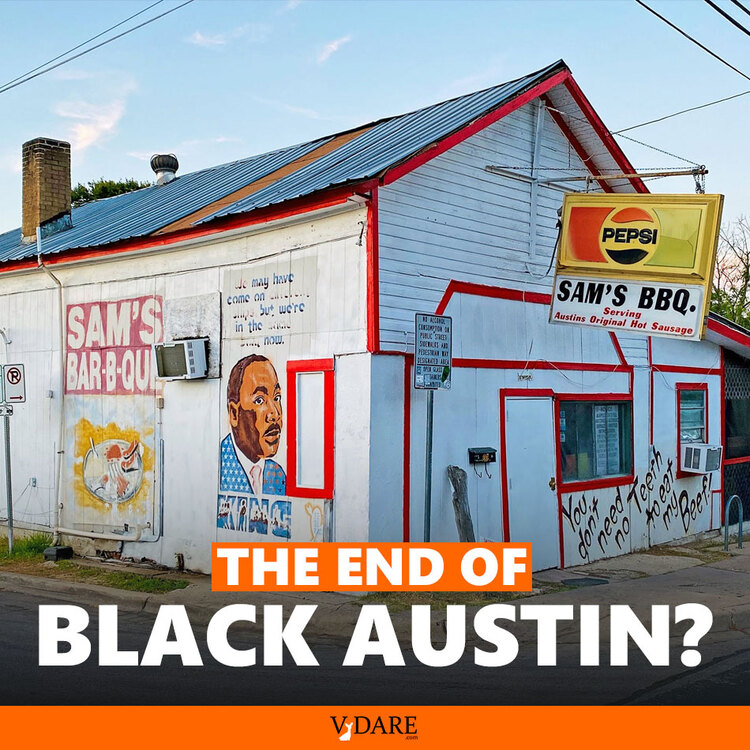
San Antonio Anti-Gentrification Article Inadvertently Shows Influx Of White People Improving Quality Of Life/Property Values
By Paul Kersey
02/14/2024
Could one story illustrate the destructive nature to property value of a community devoid of white people and the incredible accumulation of wealth possible for black individuals who get to see their formerly all-BIPOC community blessed with an infusion of white people to the point of them becoming a majority?
Some might call it gentrification.
Sam’s BBQ continues legacy as ‘safe space’ for Black community: ‘It’s a safe space, [but] at the same time a memorial,’ by Cristela Jones, MySanAntonio.com, February 5, 2024
In East Austin, there sits a barbecue joint that, upon entering, is like taking a step back in time. From the smell of barbecue smoke filling your nose before even stepping through the white wooden door full of stickers, to the rustic brown wooden panel walls inside, and vintage letter board listing the restaurant’s five barbecue meats by the pound, history is engrained in the space.
Each meal, whether dine in or to-go, is served on a styrofoam plate with meats like brisket, pork ribs, sausage, and chicken, along with sides of potato salad, macaroni and cheese or baked beans, and their choice of sodas in a small ice chest nearby, similar to a family reunion cook-out. This home-style barbecue cooking and comfort inside is what Sam’s BBQ Owner Brian Mays says keeps people coming.
“[BBQ] is what we had, we didn’t want nothing else,” Mays said. “You gotta do what people like.”
Mays is 70 years old and has been the owner of Sam’s for 49 years. He grew up on the Eastside of Austin working in the restaurant with his father, who bought it in 1957. Sam’s BBQ has been around for 67 years and is one of the last Black-owned businesses left on the city’s eastside. It’s also one of the only traces left of what used to be a predominately Black and Hispanic neighborhood in Austin.
“It was Eastside. We had 500 Black businesses over here,” Mays said.
Before Sam’s came to be, East Austin was named the “Negro District” in the city’s 1928 urban plan to force Black residents to live within a six-square-mile radius to maintain Jim Crow era segregation policies, according to the six square website. Over the years, the neighborhood grew to become a vibrant community filled with thriving Black businesses, schools, and churches. That was until Mays said he started to see a change in the late 1990s.
“Everybody shut down because of gentrification,” Mays said. “They been doing gentrification a long, long time ago. But see I own my stuff I don’t rent.”
Black and Hispanic residents began to be disproportionately bought out of their homes, including Mays who sold his family’s home for $4.8 million in 2010 and now commutes to work from Manor. But as the City of Austin started to look different, Sam’s stayed the same. In the past decade, developers offered Mays millions of dollars for his Sam’s property, but he refused to sell.
“When you sell your business, what you gonna have left?” Mays said. “That’s all you have. My brother work here, he been here a long time…my daughter work the daiquiri shop next door…when I die I’ll make sure they get a million.”
Mays, who has 18 kids and 48 grandkids, has also taken in community members like Marcus Truth, who grew up on the streets of Austin and now works in the media industry in California. Truth said coming back to visit Mays and his family always makes him feel at home.
“It’s a safe space [but] at the same time a memorial as well for people who was in the old East Austin when it was all Black and it was segregated,” Truth said. “Generally growing up as a Black person, we didn’t have a white experience. It was Black and Mexican. Brown and Black, and the rest of it was you in foreign territory.”
If the community was so vibrant and thriving when it was all-black in the 1990s, why were white people able to buy up property so cheaply then, to the point that once it became majority white (via gentrification), a black owner of residential property was able to sell his home for $4.8 million?
What was that same home worth when the community was all-black, totally devoid of white people? How did it magically appreciate to be worth $4.8 million upon the neighborhood flipping from all-black people to majority white?
So much about the United States of America post–Civil Rights Act of 1964 is on full display in this article. Few will understand the true lesson.
